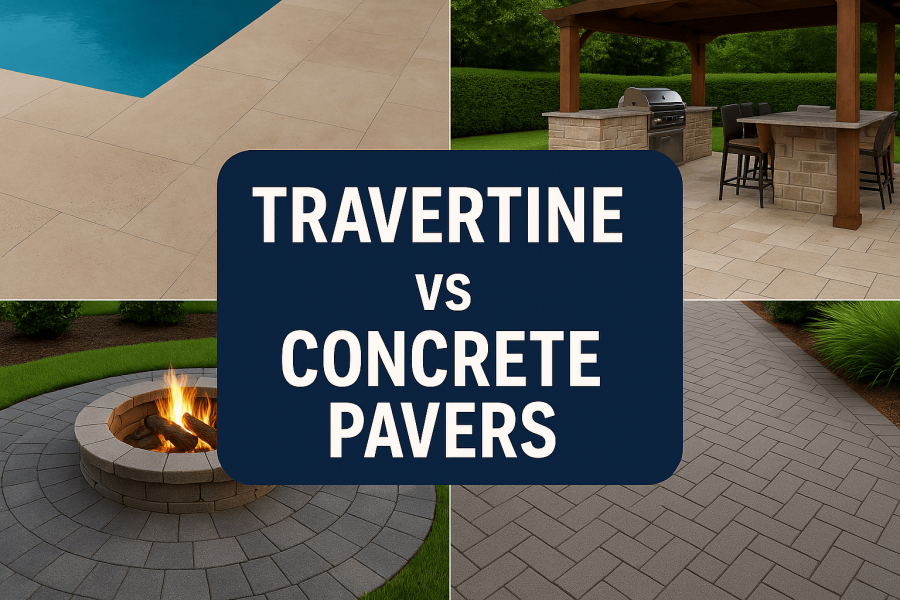- >
Homeowner’s Guide to Improving Drainage in your Lawn
- By: Cheli Scott
- Date: Jan 05 2023
Similar Articles
Artificial Turf vs Sod for Lawns, Backyards & DIY Makeovers
Thinking about artificial turf or sod? Discover the pros and cons of each—from cost and maintenance to durability and pet-friendliness—so you can choose the best option for your lawn or backyard project.
Travertine vs Concrete Pavers for Florida Pool Decks, Patios, Fire Pits & More | bhild
Compare travertine and concrete pavers for Florida pool decks, patios, and driveways — from heat retention and slip resistance to cost, maintenance, and curb appeal.
Beat the Heat: Florida Summer Landscape Survival Guide
Beat the Florida heat with smart summer landscaping. From drought‑tolerant plants to shaded retreats, this guide covers designs, materials, and maintenance tips to keep your yard thriving all season long.
Homeowner’s guide to improving drainage in your lawn
If you are finding puddles or muddy spots in your yard it is time to look improving drainage in your lawn. Soil drainage is essential to the health of your garden and should be a priority for any homeowner.
Lawn drainage issues can seem overwhelming, you can’t control heavy rainfall so what can you do? Actually, there is a lot you can do to help with yard drainage problems. We’ve assembled some tips on how to identify and some yard drainage solutions to get you started.
How to identify drainage issues
The most obvious sign of lawn drainage problems are the accumulation of puddles after rain. Because of the erosion caused by the water, you may find low spots in your yard or areas where grass and plants have died away. You may even find stains on your home’s foundation where water is collecting.
Why poor drainage is a problem
Poor drainage can kill plants and grass leaving your yard a barren, muddy mess. It also endangers your home and any decking or patios you may have. Built up water can cause rot and mold on these surfaces.
Why you are experiencing poor drainage
Commonly, drainage problems are caused by clay soil. Clay mixed in with your soil will prevent water from draining in a reasonable am0unt of time after a rain.
There are other things that can contribute to poor soil drainage, as well. Compacted soil from winter weather or construction can prevent water from draining.
Over time erosion or poor planning can adjust the pitch of your yard, causing water to flow and collect around your house. Additionally, poorly maintained gutters or downspouts that down pull water far away from your home can cause drainage problems.
Things you can do to improve drainage
There are a number of DIY solutions to yard drainage issues that only require a bit of your time and some sweat, however for more serious drainage issues and drainage system installation, it’s best to enlist the help of an experienced landscape professional, who can perform soil drainage tests to make precise recommendations and ensure proper installation.
Things you can do yourself to improve drainage
Extend your downspout and maintain your gutters
Gutters move water off of your roof and into spouts that drain water into your yard, away from your home. If your downspout dumping too much water right around your house, it may be building up, causing rot and damage to your home and patio.
To solve this problem, you can buy an extension for your downspout from your local hardware store and extend it to direct the water flow further away from your home.
Full gutters can dump water down the side of your house instead of being funneled where you want it to go. Be sure to check and maintain your gutters as your drainage problem may have a very simple solution.
Aerate
Keeping your lawn aerated is great for your grass, allowing nutrients and water to get to plant’s roots. Light aeration can be done with a rake or you can rent an aeration machine from your local hardware store to pull small core spikes from your lawn, allowing water to pass through easily.
Mow and properly water your lawn
A tidy, mown lawn will discourage standing water and encourage roots to grow properly. For the best drainage you want grass roots to be deep, not shallow. To encourage this, water deeply less often, rather than watering frequently and lightly.
Grow plants
Plants help with drainage, sucking up excess water. Choose water loving, native plants in low or wet areas to improve both the look of the area and the drainage.
Things you may want professional help with to improve soil drainage
Install permeable paths and turf
Hardscape can cause drainage problems if it is not correctly installed or well thought out. If you are having problems with excess water build up, go for permeable paths that water can drain through.
Consider having artificial or natural turf professionally installed to be sure it is put in correctly with proper drainage.
Build a pond
A professional landscape contractor can help you plan and construct a pond to manage your drainage problem. Ponds are a great way to collect excess water and can be beautiful, when paired with water loving plants, fish, and hardscape.
Install a dry well
You will probably also need the help of a landscaper to construct a dry well. These are holes where perforated rain barrels are buried to collect and hold water until it seeps into the ground. Dry wells should be able to catch 10 or 15 minutes worth of water from a rain storm.
Install a French drain
A French drain is another form of drainage system that involves burying a perforated pipe to allow water to drain from the soil into the pipe and eventually the water flows to where the pipe directs it. In order to install a French drain you will need to dig a pretty extensive ditch and do a little bit of drainage system planning. This is usually best and most easily accomplished with the help of a landscaper.
Build a dry creek bed
Dry creek beds are simple drainage systems. You can dig a trench where water flows after heavy rain and line it with landscape fabric and nice looking river rock. This allows water to flow away from your home and to natural low spots in your garden. While you can accomplish this yourself, a landscaper can also help you plan and construct this type of drainage system.
Construct a rain garden
A rain garden is a beautiful way to manage surface water. Essentially, a rain garden is a garden planted at a low spot or natural water collection point in your yard. By populating it with native, water loving plants you give water a place to sink into the soil as well as plants to suck up excess moisture.
Again, while you can dig and construct a rain garden yourself, you may find you achieve better results with the help of an experienced landscaper who can perform soil drainage tests to help you choose the best location.
When to call for help
Drainage is a serious lawn issue that can cause major damage, so consulting a landscaping professional to come out and perform an assessment is encouraged if you find you have problems simple solutions can’t solve.
Be sure to work with an experienced professional like the ones at bhild.com. Call us today, or fill out our form here for a free estimate on lawn services!

















